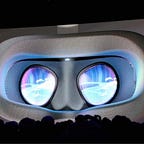VRLA Pre-show Showdown: Vive Focus vs Oculus Go vs the Lenovo Mirage Solo
Between GDC, GTC, F8 and VRLA I have had a chance to try the Vive Pro, Vive Focus, Lenovo Mirage Solo, and the Oculus Santa Cruz, today we are going to compare the Focus to the Go to the Mirage Solo. My brutal comparison in text can be found at the bottom of the article.
Written by Micah Blumberg regarding a podcast with Kevin Kunze and Kurt Stoffer.
See how they fared in our preview:
Vive Focus below
Mirage Solo below
Oculus Go below
Comparison Specs
Oculus Go 5.5” 2560 x 1440 WQHD with 538ppi, 75hz, 2 hours game battery life, 2.5 media battery life, Snapdragon 821 $199 Sharpest & Best Display by initial comparison
Mirage Solo has a 2560 x 1440 LCD 75HZ, fov 110, general usage: 2.5 battery hours, 835 snapdragon processor, costs $399
Vive Focus has 3K AMOLED resolution of 2880 x 1600 75hz, fov 110, 835 snapdragon processor, costs $3,999 Chinese Yuan equals $628.00 US Dollar
The Comparison in words:
The Vive Focus has the highest res screen on paper, but I like the lenses on the Oculus Go the best, it seems sharper and more crisp, Oculus brags that these are the best lenses they have ever shipped better than even the Rift, and it shows. I’d rather watch movies in the Go as far as screen sharpness goes.
At F8 I learned that for all Gear VR users 99 percent of the usage is for watching media, ie movies like Hulu, Netflix, and 360 films. That 1 percent is for games. So that means 99 percent of the time people will not make use of the advanced position tracking 6 dof features in the Focus and the Solo that let you walk around inside VR, most people will just watch movies and media that works fine when seated or lying down.
I think that all three companies should have invested in 6dof controllers, so that you can have your hands in VR and not worried so much about putting 6dof into the headset itself.
The three headsets are estimated to have between 2 hours and 2.5 hours of use. The Solo and Focus have a slightly more powerful processor but who knows how much of that additional power is being lost to position tracking.
The Solo is $399, the Focus is $629 in China, and the Go is $199. This makes the Go the best value VR headset in the world for consumers. Professionals may want the high capacity of the Vive Focus MicroSD card slot. The Lenovo Mirage Solo has the Daydream library of apps that Vive Focus does not have, and a MicroSD Card slot. The biggest failing of the Go comes down to the lack of a MicroSD cardslot but with its sharp screen and comfortable fabric I would rather put on the Go than the other two.
The Go comes with 1000s of apps that previously ran on Gear VR, the Solo can make use of all Google Daydream apps, the Vive Focus may have the least amount of app support currently with only Viveport Focus apps being available
Focus users have to start over with a new app store instead of making use of legacy apps from Gear VR (for Go) and Daydream for the Solo.
Note: The argument I am making is that mobile VR will be used for watching media in the future based on a study of the past and that the addition of 6dof is completely incidental for watching media/movies in a VR Headset based on historical data. 6dof or position tracking technology could play a factor in changing that number but I do not expect it to change by that much. Call it a prediction I am making, a hypothesis about the future based on evidence from the past.
What should make a much bigger change in how people will use Mobile VR may come from the availability of position tracked controllers that allow your hands to be in VR.
Note 2: What puts the Vive Focus, the Mirage Solo, and the Oculus Go in the same league is the single 3dof controller all three have that turns into a laser pointer in VR with limited value for increasing immersion. Essentially your hand movements are not in VR and thats bad for all three systems.
Oculus Santa Cruz is in a league all on its own because with the Santa Cruz you have both your hands being tracked in VR.
Above: Spec Comparison of Vive Focus, Lenovo Mirage Solo, and Oculus Go.
Read more stories:
